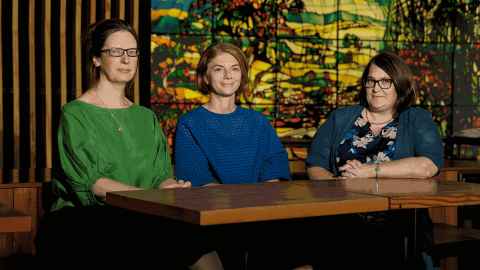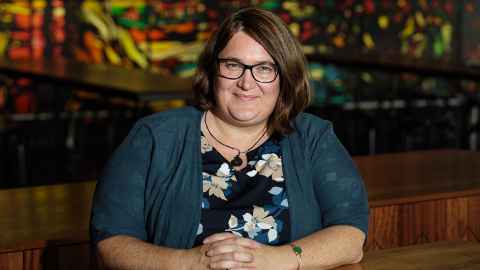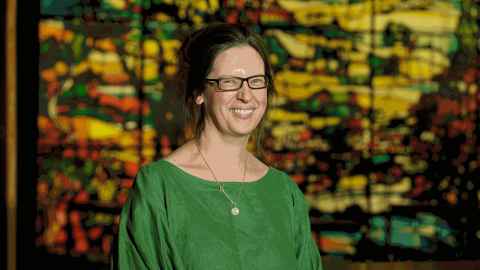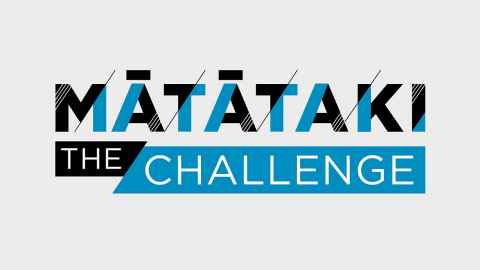Rheumatic fever: time to stamp out this deadly and preventable disease
29 March 2022
Aotearoa New Zealand and Australia are the last high-income countries in the world with significant rheumatic fever. Three University researchers are leading a $10m project to stamp out the deadly disease.

The 10-year-old girl arrived at Katherine District Hospital, 360km southeast of Darwin in the Northern Territory of Australia in serious strife.
She had already come a long way from her home in the rural hinterland. Katherine District Hospital is small, a 60-bed hospital providing community care and not set up to handle complex health emergencies.
New Zealander Dr Rachel Webb was then a house officer at the hospital, training to be a paediatric specialist. “The child presented in severe cardiac failure, similar to an older person in their 70s or 80s with congestive heart failure.” One of her heart valves had acutely ruptured. Darwin was too far away. “Despite our best attempts at resuscitating her, we weren’t successful,” Webb says.
The girl’s death was due to the worst consequences of rheumatic fever. The knowledge that the disease is entirely preventable made her death worse for Webb and her colleagues that day.
Devastating disease
Rheumatic fever is a tricky disease. What appears to be nothing more than a sore throat, if caused by Strep A bacteria, becomes a trigger leading to the immune system, in a susceptible person, going haywire. Affected children can experience swollen and sore joints, fatigue and fever. A simple test can pick up a Strep A infection, but sore throats and sore joints can easily be left undiagnosed.
Even when diagnosed, the course of treatment is at least a decade long and arduous requiring painful monthly injections of long-acting penicillin.
Inevitably each year in Aotearoa/New Zealand children and young people fall through the same gaps as the little girl in Katherine District Hospital. They face severe and, in some cases, life-threatening illness. Heart valves inflame, with cases at the worst end of the spectrum requiring surgery and long bouts of rehabilitation and recovery.
For reasons researchers still do not understand, children and teenagers are at the highest risk of rheumatic fever. For the first two decades of this century, 93 percent of initial rheumatic fever cases have been in Māori and Pacific people under 30, with the majority of those cases affecting children between the ages of 5 and 14 years.
A table of rheumatic fever rates by DHB region for 2020-21 tells the story. Northland with 6.7 cases per 100,000 people has the highest incidence. In the South Island, rheumatic fever strikes only 0.6 per 100,000 people, a hundred times less. In Auckland, Counties Manukau DHB recorded three times the rate of Auckland and Waitematā DHBs, in the Auckland region. A similar picture can be drawn in Australia where the disease almost exclusively affects Indigenous Australians.
There is an ever-growing number of young people and children facing life stunted by the disease. They become unwilling frequent fliers in the health system. The total cost of disease from Strep A is about $59m a year.
Behind the statistics lie the cumulative personal burden on families, whānau and communities. Institute of Environmental Science and Research (ESR) data estimate 159 premature deaths a year due to rheumatic fever: young people whose parents and families have had to farewell before their time.
Meanwhile, with between 150 and 200 diagnosed cases added each year, there is an ever-growing number of young people and children facing life stunted by the disease. They become unwilling frequent fliers in the health system. Studies estimate the total cost of disease from Strep A at about $59m a year.
Children and teenagers with rheumatic fever and their whānau learn that there is currently no cure. For the majority, it means a childhood marked by approximately monthly visits for a least ten years to a hospital or clinic to receive an intramuscular injection of antibiotics to prevent rheumatic fever developing again. For people with severe rheumatic disease, injections often continue until at least 30 years of age. Cardiology follow-ups will be for life.
No matter how brave, nobody likes an intramuscular injection, a painful procedure now commonly administered with anaesthetic. Failure to maintain the strict regimen of treatment can result in worsening heart damage and rheumatic fever recurrences. Severe rheumatic heart disease can lead to open heart surgery, in some cases with children as young as five.
The project name 'Rapua te mea ngaro ka tau' can be interpreted as 'The end to seeking that which was hidden', drawn from an initiative by Tainui King Tawhiao.
That’s the bad news. The good news is that a new research project aims to end rheumatic fever. Named 'Rapua te mea ngaro ka tau', the principal investigator Associate Professor Nikki Moreland has brought together a co-leadership team that includes Rachel Webb in the clinical space and Dr Anneka Anderson, (Kāi Tahu, Kāti Māmoe) a medical anthropologist in the community space.
The name: Rapua te mea ngaro ka tau, which can be interpreted to mean ‘The end to seeking that which was hidden’ was gifted to the research by kaumātua at Te Kupenga Hauora Māori at FMHS. Its origins reflect an initiative by Tainui King Tawhiao who sent prophets from his people on a quest to seek out the hidden potential in adversity. The researchers acknowledge the kaumātua Whaea Julie Wade and Dolly Paul, (both Tainui) and Matua Shannon Leilua (Ngati Whātua) for sharing their mātauranga Māori in support of the project’s kaupapa.
The Aotearoa New Zealand project partners an Australian project with a similar kaupapa. With funding of $10m, the three researchers are mapping a battle against the infectious disease on three fronts:
- Enhanced surveillance of Strep A infections
- Expanded infrastructure for laboratory assessment of vaccine
- Clinical development of vaccines

Anderson, whose work will take her to a series of communities at the sharp end of the disease, says those experiencing the disease will always be the best guide to what works for them.
As an anthropologist, her focus is on the social and physical environment and how they influence transmission of Strep A. She takes a kaupapa Māori approach. “I’ve always felt that this is a story about the mismatch between the New Zealand health system and the whānau context,” Anderson says.
She cites a list. DHBs deliver services differently. For some, the monthly intramuscular injection is an outpatient clinic visit, for others, it is delivered in the community. There’s no national register for the illness. “So, say I live in the Waikato and am staying with whānau in Tai Tokerau, the nurses there aren’t going to know I need an injection.”
Traditionally the health system divides the population into two camps, children and adults. Teenagers, she says, can fall between child and adult health services. Perhaps most difficult of all to address is the stigma experienced by those with the illness who are often perceived as ‘the problem’ ignoring the true structural determinants of the disease.
Rheumatic fever, poverty and racism are inextricably linked and the last thing anyone needs is to be cast within a racialised stereotype: “As one of the poor, dirty brown people who get rheumatic fever”, she says. Teenagers end up with emotional scars. At an age when sports or kapa haka are an important part of their identity, rheumatic fever prevents participation and reinforces exclusion.
Regular visits to clinics sees teens teased about what’s going on, with Anderson hearing stories of gossip about sexually transmitted disease. The burden of health is matched by the burden of shame.
The regular hospital visits and stays that become part of life for children with rheumatic fever mean families have to juggle time off work and their care for other children, compounding difficulties for households already close to the breadline.
Anderson will build on the expertise gained from the school swabbing programme and whānau-centred primary care clinics to build a more complete picture of the ‘attack’ rates, or the incidence for Strep A throat and skin infections in the community that can trigger rheumatic fever.

Webb, based at KidzFirst (Middlemore) and Starship Children’s Hospital, will be addressing knowledge and data gaps in hospital settings. The incidence of diagnosed rheumatic fever is reported, but Webb’s challenge will be to set up systems to capture all cases of Strep A infections, a broad spectrum ranging from throat, and skin infection, to blood stream infections, and immune-mediated diseases caused by Strep A including rheumatic fever, glomerulonephritis (swollen kidneys) and scarlet fever.
“There are challenges wherever you look at rheumatic fever,” says Webb. Children and young people with Strep A experience a wide gamut of possible symptoms that can threaten multiple parts of the body, from the kidneys to the heart and brain.
Rheumatic fever occasionally causes a form of brain inflammation, called chorea, which a serious movement disorder. Anderson says, “For these kids, even holding a pencil or trying to work an iPad is incredibly difficult. They live with jerking and twitching that is a huge social cost for a young person.”
Between them, Webb and Anderson will build the most comprehensive map of Strep A disease the country has had. By seeing what happens when children and young people develop Strep A infections in the community and at hospital, the researchers aim to lift the effectiveness of community, clinical and medical intervention.

Part of their work will be to identify the most common Strep A strains circulating in Aotearoa New Zealand. The database lies at the heart of Moreland’s role.
Her laboratory at the Faculty of Medical and Health Sciences at the University will use the ‘library’ of New Zealand Strep A strains to inform the suitability of a vaccine for our country, in partnership with the parallel effort in Australia.
The laboratory has already refined some of the tools needed for assay testing, which provides a means to measure the level of antibodies a vaccine produces. This funding will enable the capability to be expanded so that, in time, the assay work will provide evidence of the effectiveness of future vaccine candidates.
For Covid-19, a multitude of vaccines have been designed, developed and delivered in a year. In the immunology world that is something that has never been done before at this speed. New vaccines typically require multimillion-dollar investment and decades in labs and clinical trials.
“The challenge is that compared with bacteria, a virus is generally relatively simple to develop a vaccine for. A bacterium is much more complex and much larger,” Moreland says.
The Covid vaccines rely on ‘de-fanging’ the spike protein, common to the Covid strains. Bacteria are different. “They don’t have the same structure repeated over and over. They’re really heterogeneous.”
With more than 200 strains of Strep A circulating in the world, the work would go nowhere without the investigation of local strains. The strategy behind the Government’s $10m investment is to get all the building blocks in place for vaccine development.
Globally, the disease affects people living in low-income countries. They are not populations that attract large investment from multinational pharmaceutical companies. That makes this Government investment even more crucial. As well as laying the groundwork for future vaccine development, the project will also give the fuller picture of the disease to inform better prevention and treatment of rheumatic fever right now.
The focus is on children and young people in New Zealand, but Moreland notes that a successful Strep A vaccine would also meet a much larger need. When all tallied, Strep A infections, including skin and tissue infections that in turn lead to pneumonia, necrotising fasciitis (flesh-eating disease) and toxic shock is in the 'top 10' causes of deaths by an infectious disease worldwide.
The project runs to 2024, by which time the researchers plan to be readying for a clinical trial of a vaccine candidate. Moreland says,” This will take perseverance. Yes, the long-term goal is a licensed vaccine, but what’s equally important is the new information we will find to improve how we respond to the immediate needs of people who have rheumatic fever.”
Moreland describes rheumatic fever as an ‘immunological challenge in one disease’. In hospitals, Webb has worked with colleagues from the UK who had never encountered rheumatic fever, considering it a disease banished in the nineteenth century. Anderson wants a community-led approach to stop children and young people falling through the gaps in healthcare.
The three researchers would dearly love to consign rheumatic fever to medical history in Aotearoa New Zealand.

Story: Gilbert Wong
Images: Billy Wong
Mātātaki| The Challenge is a continuing series from the University of Auckland about how our researchers tackle some of the world's biggest challenges.
Challenge articles are available for republication. Please contact: gilbert.wong@auckland.ac.nz